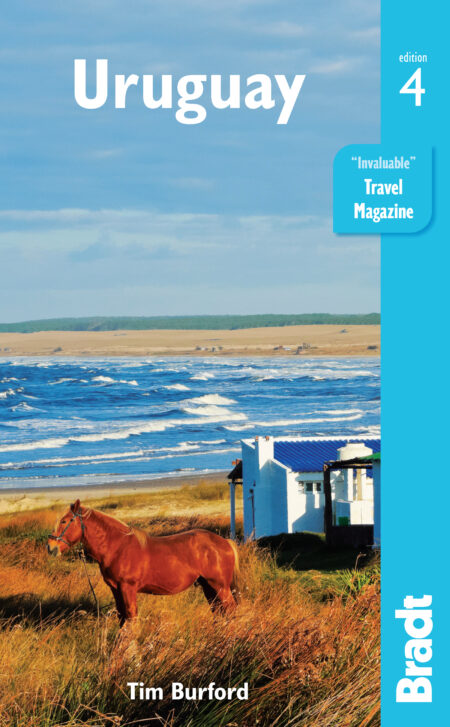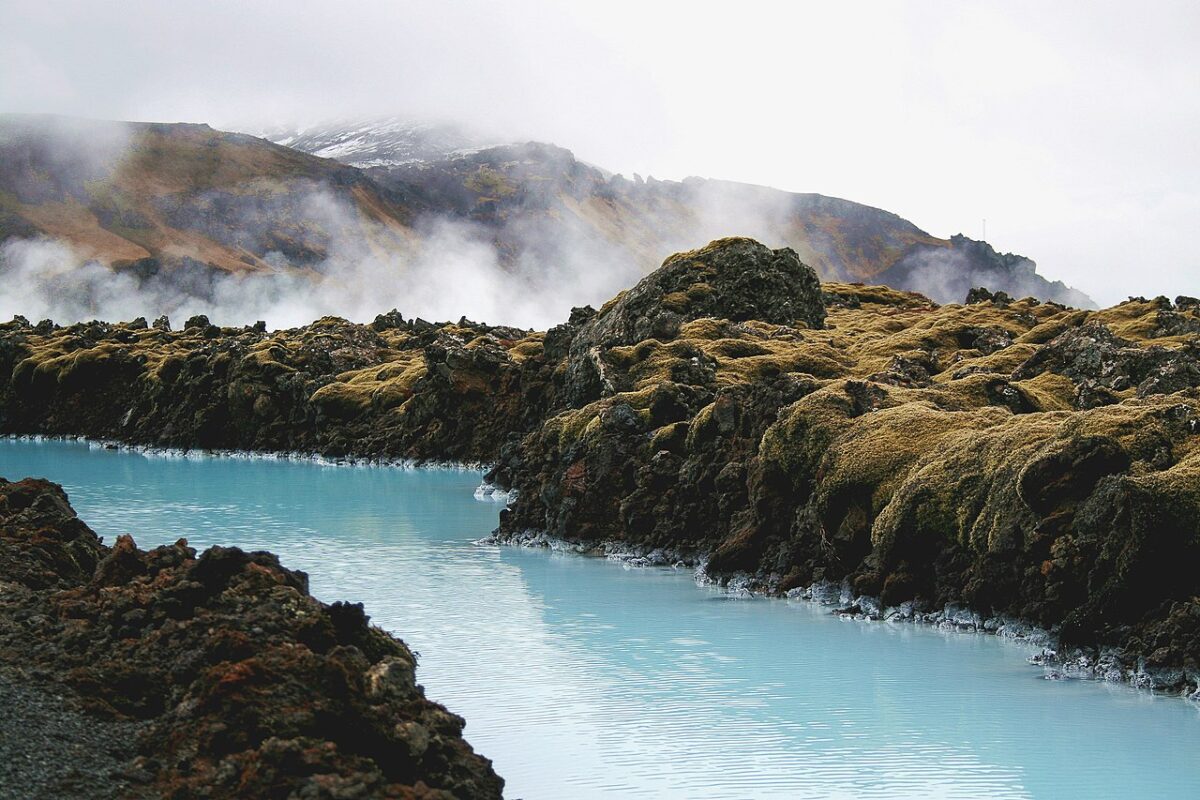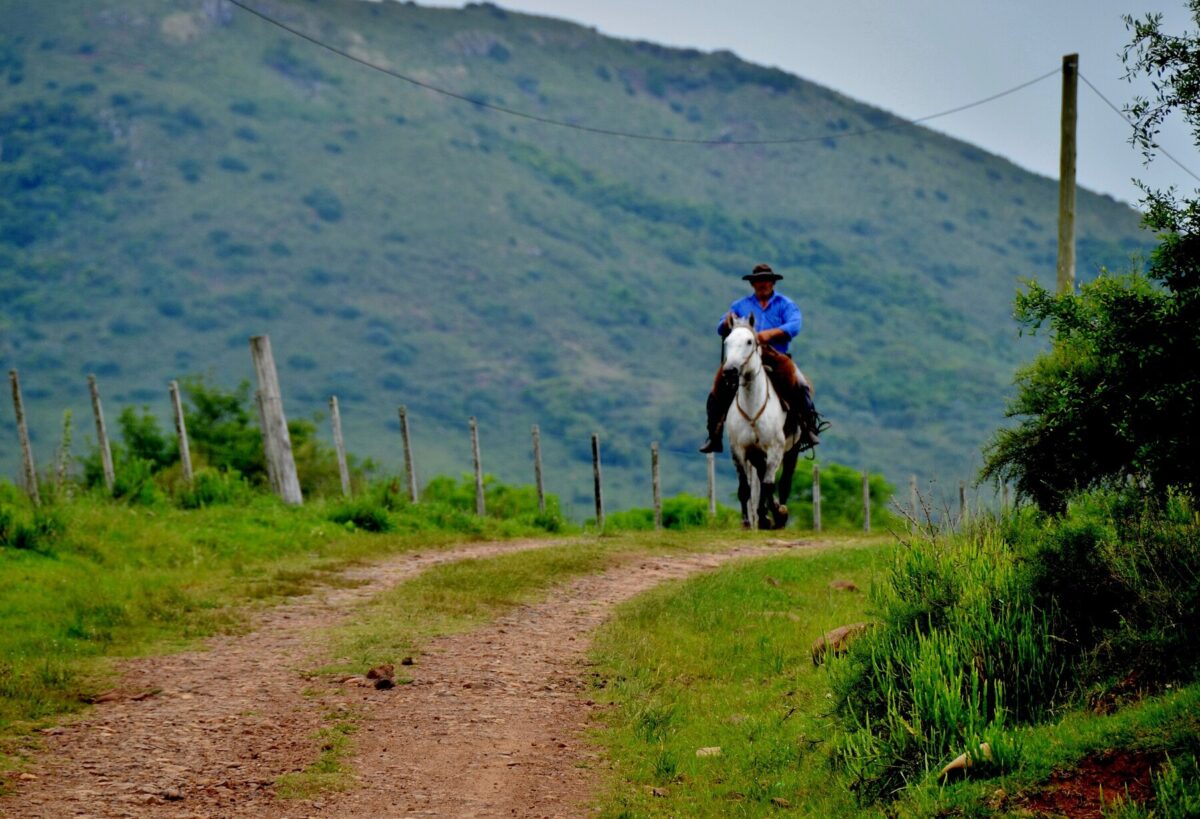Uruguay continues to be an independent country, culturally distinct from its neighbours, and it is well worth proper exploration rather than a flying visit or a week spent solely on the – admittedly superb – beaches.
Tim Burford, author of Uruguay: The Bradt Guide
It won the first soccer World Cup, there are places called Fray Bentos and 33, and there are a lot more cattle than people. Throw in marijuana legalisation and a famously idiosyncratic president, and you’ve got all most people know of Uruguay. Perhaps others may have seen a film about the sinking of the Graf Spee.
However, it has far more to offer the visitor, from the finest beaches and resorts in the region to traditional estancias (ranches) where you can ride with the gauchos towards the endless horizons, wetlands and lagoons with a fantastic array of birdlife and, in Montevideo, a capital that is fascinating yet laid-back, with a totally different vibe from Buenos Aires, just across the water.
Interestingly, Uruguay has a similar relationship to Argentina (and Brazil too) as Canada has to the USA, Ireland to the UK or Belgium to France – a permanent sense of being overshadowed by a larger, louder neighbour, while feeling deep inside that they are in fact the smarter, wittier, more creative ones. Indeed, the Uruguayan people are less party-loving than their neighbours in Argentina and Brazil, but more reliable and genuine, with a deep and innate sense of hospitality that delights all who take the time to get to know them. Having said that, come high summer resorts such as Punta del Este are packed with Argentines who ensure non-stop partying for a couple of months at least. And let’s not forget the world’s longest carnaval season, mainly in Montevideo but in other towns too, when Uruguayans show that they really can let their hair down.
Known in full as the República Oriental del Uruguay (the Eastern Republic of Uruguay), the country takes its name from the River Uruguay, which probably derives from the Guaraní for ‘River of Birds’. The term ‘Oriental’ comes from ‘Banda Oriental’ (Eastern Shore), the name of the Spanish colonial province that eventually achieved independence from Argentina, its neighbour on the western shore of the Río Uruguay. It is not, as some might think, due to a mistaken notion among early explorers that Uruguay was in the Orient, close to China, Japan or India.
Uruguay continues to be an independent country, culturally distinct from its neighbours, and it is well worth proper exploration rather than a flying visit or a week spent solely on the – admittedly superb – beaches.
For more information, check out our guide to Uruguay:
Food and drink in Uruguay
Food
Although Uruguay is famed for its steak and other meat products (even better than Argentina’s, at least according to the Uruguayans), there’s also a great range of Italian dishes in almost all restaurants which makes the country surprisingly welcoming to vegetarians. There’s also a strong Spanish influence (especially in seafood, where the Basques excel), as well as Slav and Jewish influences.
A traditional asado grill should begin with offal – mollejas (sweetbreads), intestines, chorizo sausage – although strangely gringos often choose to skip this stage, or to have provoleta (grilled provolone cheese with herbs). Then comes the full parrillada, a grilled selection of lomo (steak), chops, ribs and sausages (including morcilla blood sausages), with some grilled chicken for light relief. Potatoes and bread are frowned upon as unnecessary distractions that just fill you up and distract you from the main mission of eating meat. A few peppers, yams and other vegetables are, however, grilled alongside the meat, and use of the ubiquitous and very tasty chimichurri sauce is also encouraged.
If this kind of assault course is not what you feel like, a lighter alternative is a chivito, which is really Uruguay’s national dish, not found in the neighbouring countries. This sandwich of skirt steak includes lettuce, tomato, mozzarella, olives and mayonnaise, with possible extras such as fried egg, grilled peppers, beetroot, palm hearts, pickles and ham – it is served with chips.
Less iconic but still very popular is the panchoor hot dog, served in a Viennese roll with a choice of sauces; these are bought from carritos, the stainless-steel trailers semi-permanently parked at street corners all over Montevideo and elsewhere. Alternatively, a chorizo sausage served in a bread roll is called a choripán, as in chorizo y pan (sausage and bread).
Drink
The best bottled soft drinks are the Paso de los Toros line, produced in the town of the same name. Virtually all cafés and restaurants also offer native herbal teas such as boldo and manzanilla. You may also find other yuyos medicinales, infusions of herbs such as malva (mallow) and marcela (Achyrocline satureioides, A. flaccida), which is something like camomile, taken as a tea for digestive, gastro-intestinal or menstrual disorders and as a sedative. Marcela is also said to be rich in antioxidants so is more popular than ever, also being used in hand creams, for instance.
Uruguay’s national drink (even more so than Argentina’s) is, of course maté, the infusion of the leaves of Ilex paraguariensis, a shrub of the holly family.
Uruguayan wine can be excellent, and almost any restaurant will serve something decent. While it’s red wine you need to go with steak, white wine is very popular and is also served with orange juice (as sangría) and with apples, grapes and perhaps melon or pineapple (as clericó). Grappa (brandy) can be quite strong but is made much smoother with the addition of honey, the result being a winter warmer known as grappamiel.
Health and safety in Uruguay
Health
Diseases and vaccinations
Uruguay is a clean temperate country with very few nasty diseases or health risks, and a good standard of health care. There is a low risk of rabies and no malaria, and a very low risk of dengue fever, although in 2009 Argentina’s health ministry belatedly admitted an outbreak affecting up to 15,000 people in Chaco and other northern states. Cities such as Paysandú are working hard to eliminate the Aedes aegypti mosquito, which carries the dengue virus; you should in any case take precautions against mosquito bites in the daytime.
At the time of writing, there was no risk of zika, but it would be wise to check the ‘Other Risks’ page of TravelHealthPro for the latest advice. There is no yellow fever in Uruguay, nor is there a certificate requirement to enter the country. However, if you plan to visit countries that do have the disease, such as Brazil and rural parts of Argentina, then vaccination is recommended at least ten days before arriving in the endemic area. The vaccine is not suitable for everyone, so be sure to seek medical advice before booking a trip outside Uruguay.
Apart from yellow fever, as described above, no other vaccinations are required, but make sure you’re up to date with tetanus and diphtheria (which now come together with polio as the all-in-one Revaxis) and hepatitis A jabs. Entry requirements can be checked with the Ministry of Public Health and further information is available on the CDC website.
Travel clinics
Medical care in Uruguay is good but can be expensive; foreigners will usually be expected to pay cash, and arrange reimbursement from their insurer later. Travel insurance is essential, more so that you can be flown out if necessary. Pharmacies supply most internationally available medications, and the well-trained staff are able to supply most drugs, except for narcotics, without a doctor’s prescription. A full list of current travel clinic websites worldwide is available on istm.org.
Safety
There’s little casual crime in Uruguay, generally seen as an oasis of personal security in South America. Even so, you should take sensible precautions, especially in Montevideo. Avoid looking like a wealthy tourist: leave jewellery and other such valuables at home. If you carry a bag in addition to your pack, never put it down: keep it under your arm or over your shoulder. Do not keep valuables in it: not only can it be snatched, but it can also be picked, slit or slashed open. The same applies to a ‘bum bag’, although this is a handy way to carry a compact camera.
Divide your money and travellers’ cheques between at least two different places, in your baggage and on your body. For your passport and cash reserves, use a moneybelt, neck pouch or secret inside pocket. Alternatively, you can sew a hidden pocket into the front of your trousers or shorts. If your passport is too bulky to carry comfortably and safely, take some other form of identification, such as a driving licence or photocopies of the key pages of your passport. Keep the numbers of your travellers’ cheques, passport, credit cards and flight itineraries separate from other valuables, so that if they are lost you can replace them more easily; it’s also smart to leave them as an email message to yourself. You can even scan or take digital photos of passports and flight itineraries and attach them to your email.
Female travellers
In some ways, Uruguay is a conservative country, but it’s not ridiculously macho and religion has relatively little sway. Although gender roles are traditional, with women largely identified with child-rearing, especially outside Montevideo, female travellers can relax as this is one of the safest and most hassle-free Latin American countries. Men may shout and whistle, but as a rule that’s as far as it goes. There certainly are bars where women should not go alone, but they’re pretty obvious. Dressing and behaving reasonably modestly is simply good manners in a conservative society, but this is less necessary in the main beach resorts.
Travelling with a disability
Facilities for travellers with disabilities are very limited in Uruguay, although you’ll find that in Montevideo bus routes CA1 and 125 are fully accessible to wheelchairs, as is Plaza Independencia, according to signs posted there. Modern Antel phone centres are built to a standard design with ramped access. It was decreed that Uruguay should be accessible by 2018, and while it didn’t hit this target entirely, wheelchair ramps and accessible taxis are appearing fast. Footways can be terrible, so wheelchair users may spend a lot of time in the road – which isn’t especially dangerous, given the considerate local drivers.
LGBTQ+ travellers
Montevideo doesn’t have the kind of gay tourism scene now found in Buenos Aires, but it’s a relaxed place and there are various gay-only and gay-friendly clubs. According to the 2016 Spartacus Gay Travel Index, Uruguay is the most gay-friendly country in Latin America, and the tenth worldwide; it’s a tolerant, laid-back country where religion has little power.
Travel and visas in Uruguay
Visas
Citizens of the EU and most other European and American countries (except several ex-Soviet and Balkan states) require only a passport for visits of up to 90 days to Uruguay. The same usually applies to Australians and New Zealanders, while most African and Asian nationalities require visas in advance. As the UK is no longer a member of the European Union, documentation requirements for UK citizens may change. Check before travelling.
If you wish to extend your stay for a further three months, contact the Dirección Nacional de Migración (National Office of Migration) in Montevideo or departmental capitals – but it’s generally easier to leave the country for a night and return.
Arriving by plane, you’ll be given two forms for Immigration and Customs; they are currently in Spanish only but are not difficult to fill in (just remember that your apellido is your family name). You’ll be given a white form to keep with your passport, but if this gets lost it shouldn’t be a problem as long as you have the correct stamp in your passport. Immigration queues are dealt with pretty fast, and there are special desks for the disabled and pregnant and those with babies.
Getting to Uruguay
By air
Most visitors from Europe will naturally arrive by air. From Madrid, Iberia flies direct to Montevideo every night, code-sharing with sister airline British Airways, and offering connections from London, Birmingham, Manchester, Newcastle, Edinburgh, Aberdeen, Dublin and Cork. Air Europa is a slightly cheaper option (although with poor food), flying three times a week from Madrid (with a connection from London).
The only direct year-round flight from North America is currently with Eastern Airlines, non-stop from Miami to Montevideo twice a week; American Airlines may also fly this route seasonally.
By ferry
Several companies operate ferries between Argentina and Uruguay. The best known is Buquebus, which runs both fast ferries and traditional slower ships from Buenos Aires. These no longer go directly to Punta del Este, but connecting buses go there from both Colonia and Montevideo. Fast ferries reach Colonia in an hour from Buenos Aires or Montevideo in 3 hours, while slower ships are scheduled to take 3 hours to Colonia. Both types of vessel carry cars.
Getting around Uruguay
By car
Uruguay has excellent infrastructure, with modern main roads (rutas nacionales) and bus stations. Many minor roads (caminos) are unsurfaced but decently maintained, though you should be prepared for pot-holes on some interior routes, even major ones.
The main roads from Montevideo to Colonia and Punta del Este (Ruta 1 and the Ruta Interbalnearia, abbreviated to IB) are toll roads, and there are tolls on other main roads, often at departmental boundaries; these are fairly inexpensive at about US$3.
By train
Uruguay’s railways were built by British companies and prospered for many years; however, in recent years they have been close to collapse and the vestigial passenger services have indeed been suspended at times. At the time this was written, there were no services except for a daily train from Tacuarembó to Rivera, as the government was investing half a billion dollars into totally rebuilding the 273km main line between Montevideo and Paso de los Toros, for freight from the huge new pulp mill under construction there.
The main line is set to reopen in mid 2023, and passenger services should soon restart from Montevideo to Progreso and 25 de Agosto (64km from the capital), although they’ll never be much use to tourists (unless they are extended to Florida or Durazno).
By bus
Buses will get you almost everywhere, and generally pretty punctually. Being a relatively small country, Uruguay does not generally have separate systems of local and long-distance buses, and most interurban buses will stop to pick up passengers who flag them down by the roadside. Standing passengers are allowed, but a point may come at which no more will be picked up.
The SummerBus Uruguay backpackers’ hop-on-hop-off service was introduced in 2010, running five days a week along the coast from Punta del Este to Montevideo, from there to Punta del Diablo and then back to Punta del Este, calling at many hostels along the way.
When to visit Uruguay
Uruguay can be visited all year round, but the high season is summer, from late December to February, when it’s hot and sunny and perfect for hanging out on the beach. It’s never really cold or wet at other times, but it certainly can be chilly in winter. Carnaval (carnival) is also a high point, culminating on Shrove Tuesday but starting (in Uruguay) long before then.
Climate
Being on the estuary of the River Plate (referred to as el mar or ‘the sea’), Montevideo has a more maritime version of the Uruguayan climate, ie: slightly warmer in winter and cooler in summer. In summer thunderstorms are common, and you may want a second layer of clothing in the evenings. Sea breezes bring relief from the daytime heat, but are less welcome in winter when it can really get quite chilly (although there’s really no need for the locals to wrap up as if they were in Siberia), and also foggy. There may be a couple of days with temperatures below 10°C (50°F), but they’re usually followed by warm sunny days.
Average temperatures are 23°C in summer, 17°C in spring, 18°C in autumn and 12°C in winter (when high humidity makes it feel colder). The average high and low temperatures in January are 28°C and 17°C, with a highest recorded maximum of 43°C; and 14°C and 6°C in July, with a minimum recorded of –4°C. Rainfall averages 950mm annually.
The river is often mud-coloured due to dirt but is fine to swim in, although this is not recommended for 24 hours after rain.
What to see and do in Uruguay
Cabo Polonio
Named after Joseph Polloni, captain of the Nuestra Señora del Rosario, wrecked here in 1753 (and not after a ship called the Polonio), this is one of the most alluring destinations in Uruguay for backpackers and others in search of isolation and tranquillity.
It’s a granite headland (once an island), much like Punta del Este, La Paloma and José Ignacio, with brava and mansa sides; the Playa Sur (or Playa La Ensenada) offers surfers a great variety of waves, thanks to its constantly moving sandbanks, and the Playa de la Calavera (Beach of the Skull, to the northeast, so called because of the cattle slaughtered here by the indigenous people) is the only beach on the whole coast which faces east and northeast. The beaches are always virtually empty, and to the southwest you can walk all the way to La Pedrera, seeing little more than a few shanties and shipwrecks.
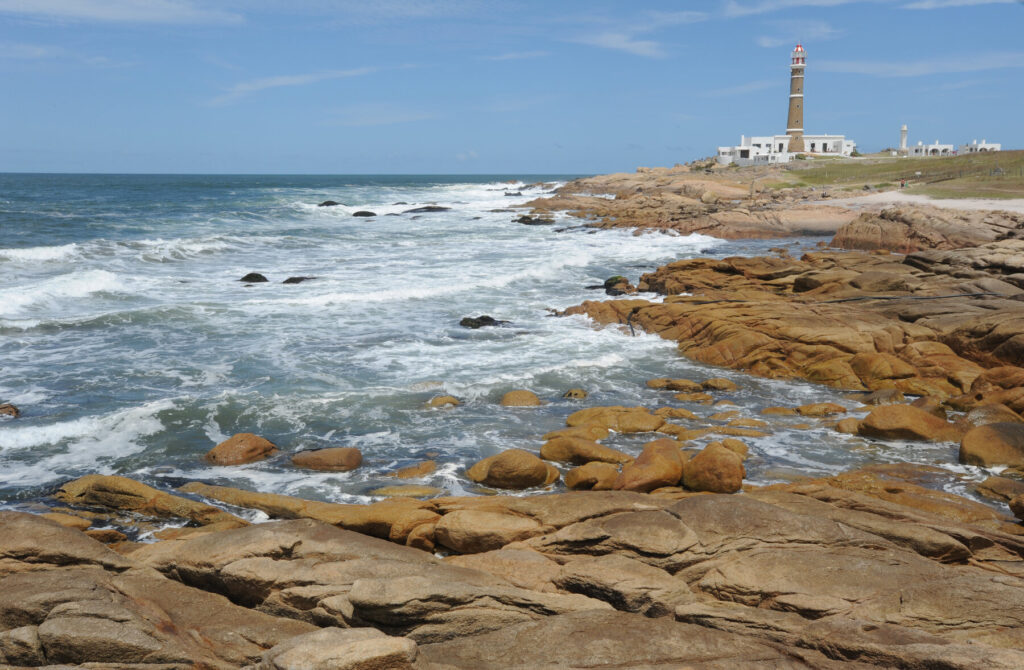
What to see in Cabo Polonio
The lighthouse, built in 1881–84, is 27m high (40m above sea level); a rough path passes between the faro and the sea lions. The Espacio Sensorial Aldea Infinita, on the so-called ‘plaza’ on the track from the bus station, has a random collection of displays on medicinal plants, pirates and the Tarot and I Ching.
There are lifeguards on the first couple of hundred metres of each beach; surfing (best in spring and autumn) can be arranged with the Escuela de Surf Cabo Polonio.
Monte de Ombúes
3.5km east of the Cabo Polonio terminal, boats leave from the bridge over the Arroyo Valizas to the Laguna de Castillos and, on its east shore, the Monte de Ombúes (ombú forest). On the hour-long boat ride, you’ll see plenty of birds such as ducks, cormorants, gulls, herons, ibis, storks, kingfishers and teros, and perhaps even wood-rails, coscoroba swans, southern screamers or flamingos.
Ombúes grow along a 25km stretch of the lakeshore, but the main grove consists of about a hundred of these odd trees with their stumpy trunks and seemingly random branches. In fact, it’s unclear whether the ombú is actually a tree or an overgrown bush – in addition to its weird shape, it has soft flaky wood that falls apart like a croissant, so that it gradually becomes hollow inside. This makes it hard to calculate their age by the normal technique of counting rings, but it seems that many of these trees are 500 – possibly as much as 800 – years old. It also means that they are not strong and can easily be blown over by a storm – hence their development in groves.
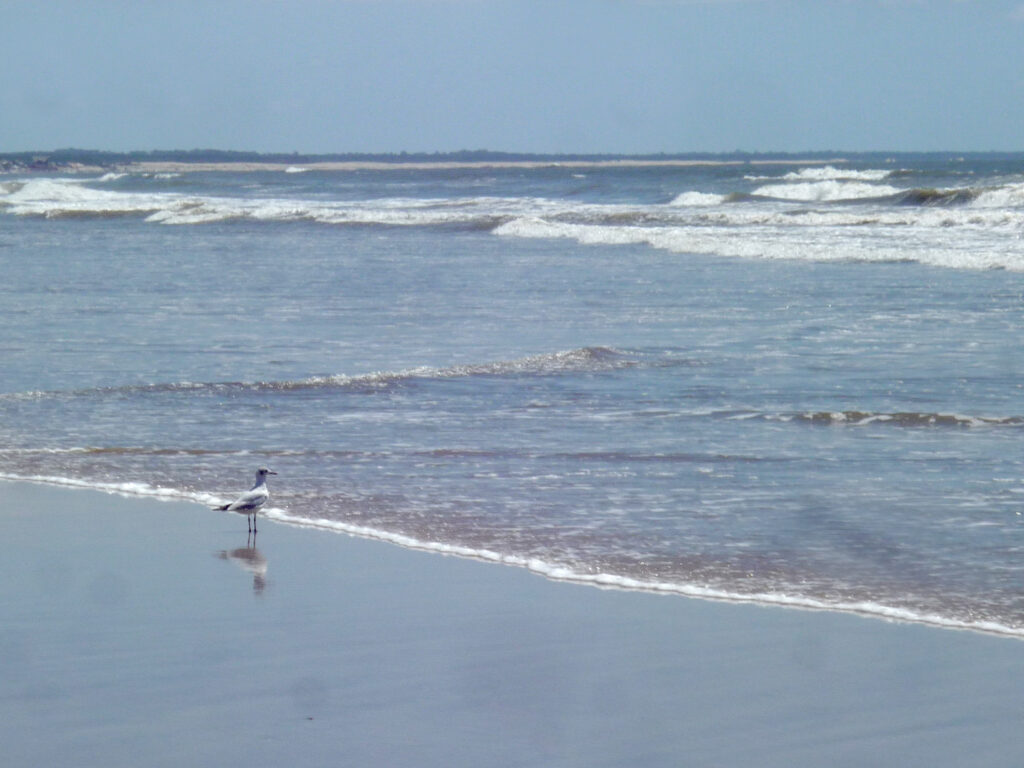
Barra de Valizas
At the start of a road leading 4km south of Cabo Polonio is Barra de Valizas, home to stunning empty beaches that stretch forever. Thatched wooden shacks serve as bars, café and shops; many open only for the summer season, but houses can be rented very cheaply so there are various alternative types here through the winter, and it has a more diverse population than Cabo Polonio.
There are plenty of hippies selling the usual beads and jewellery, as well as artists and musicians in summer; in the evenings people hang out, playing guitars and singing by candlelight. Many houses have no electricity; however, in 2009 there were protests at plans to install street lights, of which there are now a few (but the night skies are still breathtaking). There are plenty of free-range animals, and everyone seems to have a dog or three.
Canelones’ wineries
The first vines in Uruguay (probably Muscat table grapes) were planted near Colonia in 1688, and wine was soon being produced for domestic consumption as well as for Communion. In the 1870s, after the Guerra Grande, the country was stable and both agricultural investment and immigrants began to flood in. From 1880 the government began to offer incentives to the wine industry. New varieties of grape, such as Tannat, Folie Noire and Gamay Noire began to be planted, and in 1883 the first vintage was produced of what might be called ‘fine wine’, ie: something better than rough table wine made of uvas tintas or mixed red grapes.
Virtually all of Uruguay’s 270 or so wineries are small, family-run private businesses, and five or ten go out of business every year, having failed to change with the times; however, those that have adapted are doing very well. Twenty of the most export-oriented wineries have formed an association (part of INAVI) called Los Caminos del Vino – Bodegas Familiares del Uruguay (Wine Roads – Family Wineries of Uruguay), and visits can be arranged to these (they have good websites and can easily be contacted by phone or email).

Almost all are in Montevideo and Canelones departments (with a couple in Salto and Rivera), but new wineries are appearing in Colonia and in particular Maldonado, where the hugely ambitious Bodega Garzón began production in 2014. The wineries near Montevideo are mostly close to Ruta 5 and it’s easy to visit three or more in a day by car; the welcome is warm and an English-speaking guide can usually be provided. A tasting of three or four wines, with snacks and a tour of the winery, costs US$20; with a barbecue lunch it costs US$50–70. A few of the larger wineries have restaurants, but most tastings will be accompanied by cold meats and cheese or homemade empanadas. The larger wineries, close to Ruta 5, host groups from cruise ships in Montevideo harbour, and are also popular for weddings and other events.
The Wine Experience, Wine Explorers and Daniel Reyes offer upmarket and very well-informed English-language tours of Argentine and Uruguayan wineries. Private custom tours can be arranged with Lares Tours, who offer the Tannat Experience day tour, as well as two- and three-day tours with visits to wineries and cheese-makers.

In addition to tours and tastings, wineries are increasingly putting on harvest festivals(February/March for red wine, and to a lesser extent January for white) and pruning festivals(Festival de la Poda) in mid-August. The members of Los Caminos del Vino open to the public for El Día de la Vendimia, probably on the first Saturday of March.
For more information, check out our guide to the best wineries in Uruguay.
Colonia del Sacramento
Colonia del Sacramento was founded in 1680 by Manuel Lobo, Governor of Rio de Janeiro, to be a Portuguese rival to Buenos Aires, directly across the River Plate. Fought over by Spain and Portugal for almost a century (changing hands seven times between 1680 and 1778), it was known as la manzana de la discordia (ie: the apple of discord which led to the Trojan War).
Today, there are many boutique hotels and chic restaurants in old Portuguese houses, and many houses are owned by Argentines. Tourism is the main industry, but there’s a nice sideline as a location for filming adverts and historical movies.
What to see in Colonia del Sacramento
In the walled old town (a UNESCO World Heritage district), the Plaza Mayor opens in front of you, a long square planted with palo borracho (‘drunken stick’, actually the silk floss tree), figs, palms, cycads, jasmine and bougainvillea, with cotorras and swifts flying about.
To the left, the Calle de los Suspiros is the most photographed street in Uruguay, a short traffic-free lane leading down towards the Plate that is essentially unchanged from the 18th century, with its cobbles and central drain, and single-storey cottages on either side.
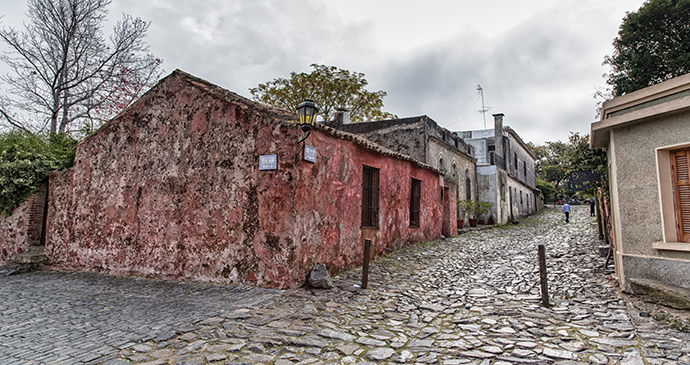
Just beyond this on the south side of the Plaza Mayor is the best of Colonia’s museums, the Museo Portugués, in an 18th-century Portuguese house, and at the western end of the plaza are other museums, the Casa Nacarello, the ruined Casa del Virrey and the Museo Municipal. To the left are the ruins of the convent of San Francisco Xavier, built in 1683 and burnt down in 1793; the faro (lighthouse) was built on its ruins in 1855–57. At 27m it’s higher than the Faro Punta Brava in Montevideo, but the stairs are better. You can just make out the towers of Buenos Aires on the horizon, to the left of the leftmost islet (with a navigation light on it).
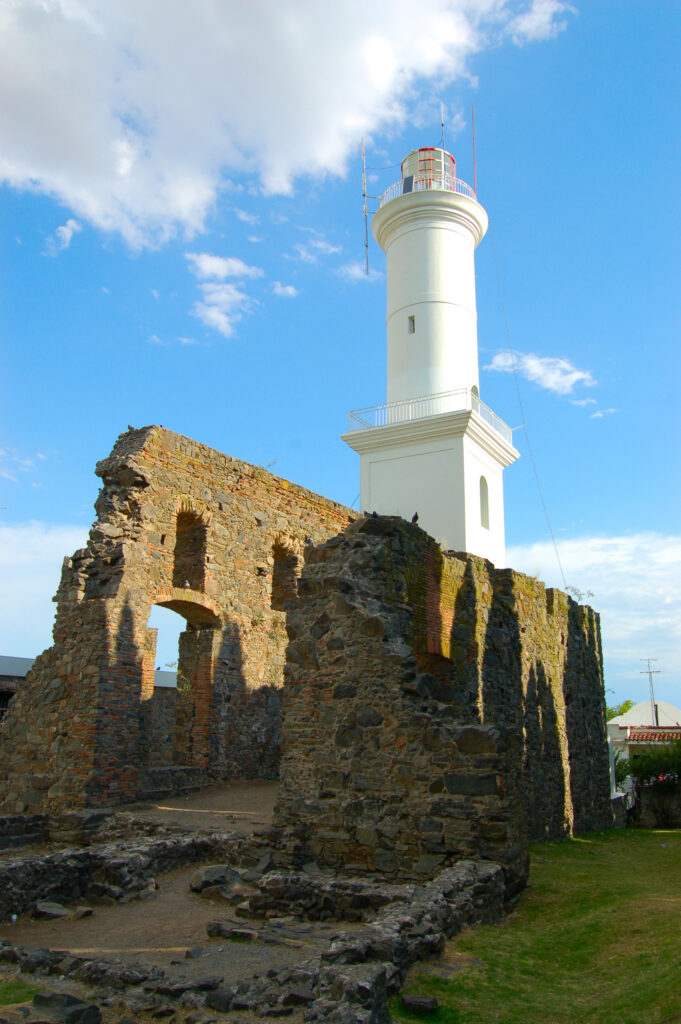
The Basilica del Santísimo Sacramento (Basilica of the Holy Sacrament), is the oldest in Uruguay. It was rebuilt between 1836 and 1842 and restored between 1957 and 1995 although, with its plain white exterior and interior, it’s not especially attractive.
On the south side of the church is the Plaza Manuel Lobo, an attractive park at the heart of what was the Portuguese fort. The Casa del Gobernador (Governor’s House), ruined by the Spanish in 1777, was excavated in 1990–93 (some of the finds are on display in the Archivo Regional) and the foundations have been restored, with walkways through and over them and interpretative signs (in Spanish only).
At the north end of Ceballos by the harbour, the Bastión del Carmen, built in 1722–48, marked the northern end of the city wall. It was demolished in 1859 but its foundations are still visible near the 38m-high chimney of a soap factory, built in 1880, that went bankrupt when its owners lost a lawsuit with an Argentine company. Now it houses the Teatro y Centro Cultural Bastión del Carmen, with an attractive waterside garden and sculpture.
Estancia La Sirena
Estancia La Sirena is a delightful, historic ranch situated in the north, near the river. Founded in the mid-18th century, the house was a virtual fortress in the lawless 1820s. It was sold to Bernardino Rivadavia, who had been first President of Argentina but then went into exile, who built the current house (in 1830) but soon sold it. Now the house is surrounded by huge eucalypti full of cotorra nests, with views west as far as Fray Bentos. Near the river is gallery forest with algarrobo trees over 800 years old, and lots of birdlife (129 species in all).
The wonderfully hospitable Bruce family created one of the first tourist estancias in Uruguay, while also raising Hereford cattle and collecting tennis cups. There are two bedrooms in the main house with the kitchen and dining room, and six newer rooms in a converted barn, with fans but no air conditioning or television. It can seem like being sucked into an endless family holiday, with horseriding in the morning, followed by lunch and a siesta, then boating on the Río Negro, then perhaps sundowners on a sandbank and an asado.
The Bruces are often in Montevideo these days, but on-site manager Gonzalo is equally charming, and with luck either he or Lucía will get out a guitar and teach you the gaucho version of Blue Moon. Waterskiing is available, and they offer two-day canoe trips from the Palmar Dam and four-day horseback trips for groups. Day rides and all other activities are included, for US$135 per person full board (on a double basis).
Fray Bentos
To Uruguayans, Fray Bentos is known largely for its international bridge to Argentina and the blockades that kept it closed as a result of Argentine dislike of the Botnia paper pulp mill, close to Fray Bentos. To the British, however, Fray Bentos is synonymous with corned beef, and happily the El Anglo meat-packing plant has reopened as an industrial heritage museum. In 2015, the entire El Anglo complex was recognised as Uruguay’s second UNESCO World Heritage Site.
Deep water and woodland attracted woodcutters and charcoal burners, plus José Hargain, an Argentine merchant who opened a shop and bar, and the British entrepreneur Richard Bannister Hughes, who set up a meat-salting business in 1859. Established as Villa Independencia in 1857, the town was renamed in 1900 after Friar Benedict, a 17th-century hermit who lived in a cave at Bahía Caracoles, about 20km downstream.
After the meat plant closed in 1979 there followed a period of stagnation, but now it’s a city of over 23,000 triperos, with new prosperity from the UPM (formerly Botnia) mill.
What to see and do in Fray Bentos
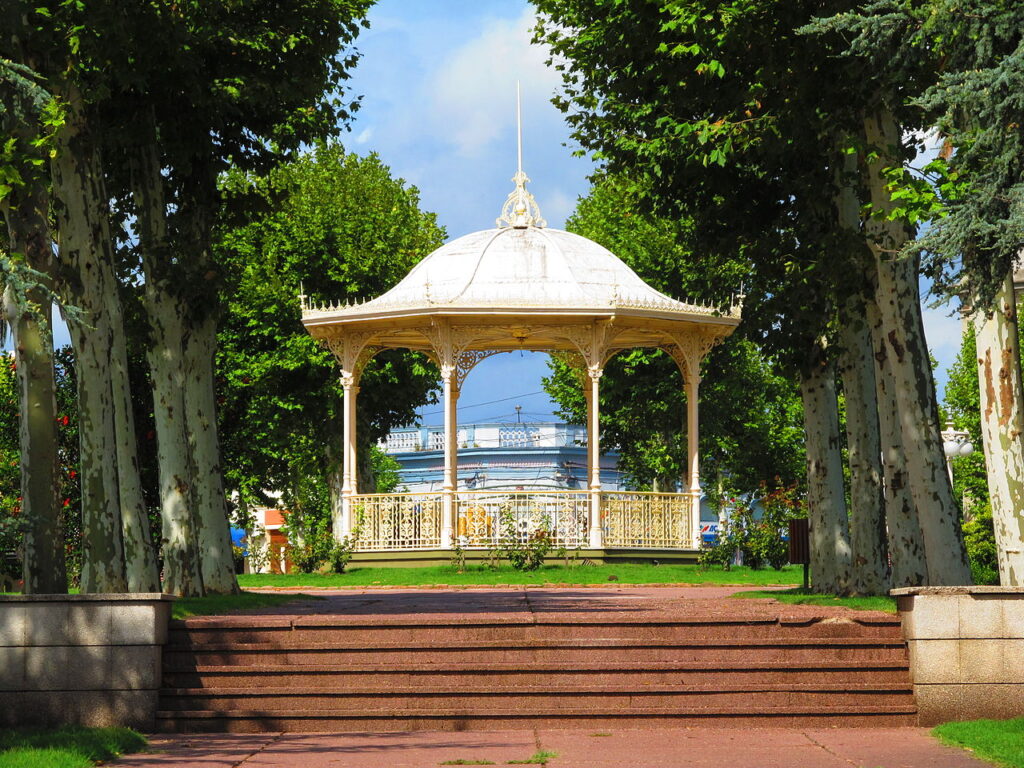
Plaza Constitución
The cast-iron kiosco(bandstand) in the centre of the well-planted and tended Plaza Constitución, raised in 1902, is a copy of one at the Crystal Place in London and has become a symbol of the town.
The grand 19th-century Stella d’Italia building (slowly receiving a much-needed refurb) on the east side of the plaza once held a cinema, while the lovely Neoclassical building on the north side, built in 1879 as a Mutual Aid Society for immigrants, is the Museo Solari. Luis Solari, born in Fray Bentos in 1918 is an artist whose style is generally naïve with fantastical subjects, often with animal heads or masks. There are also temporary shows here.

Museo de la Revolución Industrial
The Museo de la Revolución Industrial offers a fascinating insight into Fray Bentos’s industrial history. A guided tour is essential if you want to see the parts of the site not fully open to the public. For example, the cámara fría (cold store), is a massive concrete block with the word ANGLO painted across its face. This was more or less the last part of the complex to be built, in 1921–23 and 1926; 400m long by 100m wide, with 70km of ammonia gas coolant pipes, it could hold 18,000 tonnes of frozen meat. Like modern Uruguayan wineries, the process was designed to be gravity-aided, with the corrales and slaughterhouse at the highest point and the carcasses finally rolling into the cold store hanging on hooks on an open-air overhead conveyor.
Cattle were killed by a hammer to the head, then slid into the matadero or plaza de faena, where they were hooked on to the conveyor belt and systematically skinned, gutted and deprived of each internal organ in turn until the bare carcasses rolled into the cold store. For many, the most interesting part of the visit is the sala de maquinas or machine hall (1922), with huge boilers, turbines and generators produced in places such as Derby and Stoke-on-Trent, as well as ammonia compressors from Bradford and a gantry crane from Loughborough.
You enter and pay in the offices, upstairs in a warehouse built in 1872, with a central hall that once rang with the clatter of the typewriters that still sit on the ranks of clerks’ desks. Below, the main hall of the museum has some excellent displays, all in Spanish, on both technology and social history, including early posters and packaging.
Casa Grande
Casa Grande is a tranquil hotspot where Robert Baden-Powell spent a night in 1909. It has a spectacular garden and opens for free tours between noon and 14.00 on Saturdays, Sundays and holidays. An asphalt road to the right continues downriver to a viewpoint and the aduana vieja (old customs post), which is in fact a small cottage.
There are lots of loose horses and cattle which, rather bizarrely, can be seen wandering into El Anglo itself. There’s good birdwatching here, with both monte nativo and eucalyptus trees. A good road eventually continues to the beach resort of Las Cañas from here.
José Ignacio
The small fishing village of José Ignacio has recently been transformed into one of the world’s most chic and exclusive holiday destinations, with boutique hotels (and next to no budget accommodation), superb restaurants and an array of stunning modern houses.
In summer the traffic jams are mad, but from March to November this is still a remarkably peaceful fishing village. The sandy roads, empty beaches, hand-painted wooden signs and boho-chic style are key to its success, studiously avoiding the Miami Beach-style high-rise development of Punta del Este.
The first couple of weeks of January are fairly manic, with parties sponsored by brands such as Lacoste and Chivas Regal, with catering by Francis Mallmann and music by the likes of Brazilian singer Bebel Gilberto, in beachfront tents or at the La Huella Restaurant. Otherwise there’s a 02.00 curfew and there are no discos – it’s not far to the clubs of La Barra. It’s a great place to let your children loose to roam and make friends with other kids. Also in early January is the José Ignacio International Film Festival, offering a remarkably wide range of new films from around the world, shown free in the open air.
This is a place of great and subtle beauty, set on a rocky headland with the usual brava and mansa sides, and the quintessential lighthouse on the point. Set between two lagoons totalling 4,000ha, this is a paradise for birdwatchers (even the streets are named after birds), and from August to October southern right whales are easily seen from the point. Horseriding, cycling and walking are ideal ways of getting into nature here.
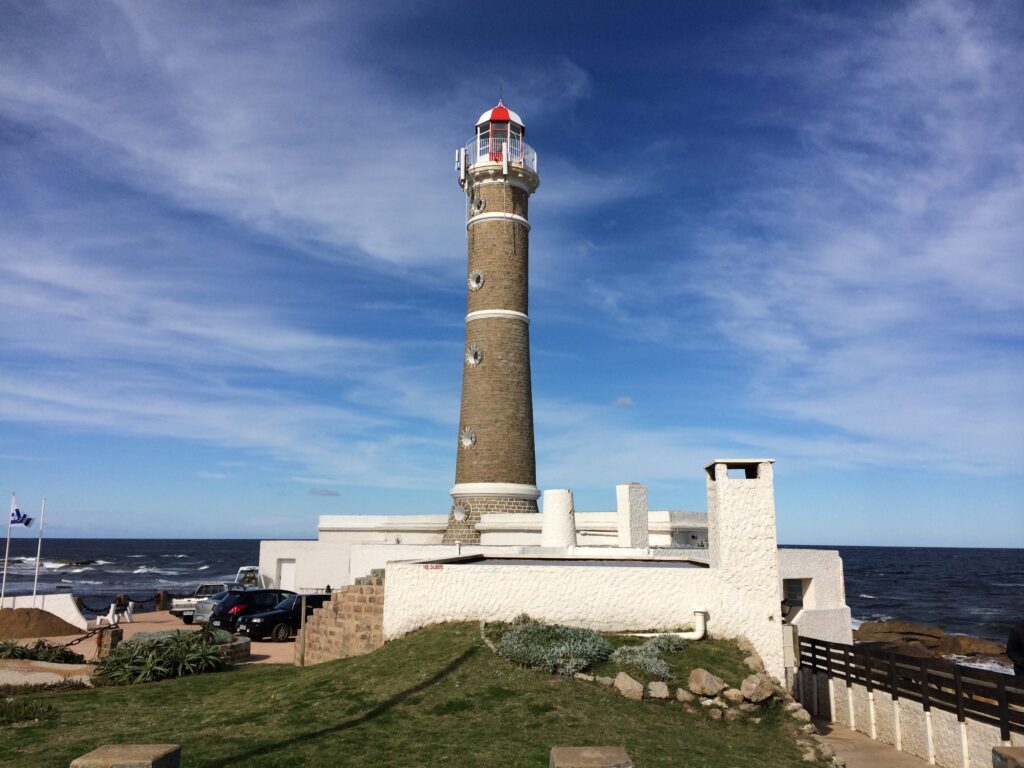
The village is named after a José Ignacio who built a slaughterhouse on the headland, an easy location for rounding up cattle. The lighthouse was built in 1877 and in 1917 the first streets were laid out as a small fishing village grew up. It was only in 2006 that luxury style magazines began to tout José Ignacio as the coolest place in the world to go for the southern summer, usually comparing it to the Hamptons on Long Island (the summer refuge for rich or famous New Yorkers).
Wealthy house-owners insist on new buildings on the peninsula being low-rise and spacious, but people worry about runaway development along the coast, although upmarket projects such as Laguna Escondida (227 lots with houses by Carlos Ott, being built just east of José Ignacio by the Cuban-American tycoon Jorge Pérez, the man who turned Miami around) and Bahia Vik (immediately west of the roundabout on Ruta 10) will not immediately lead to high-rise sprawl.
Montevideo
Uruguay’s capital, indeed its only major city, sits on the estuary of the River Plate, with 13km of beaches linked by a waterfront boulevard known as the rambla. In fact, one of South America’s finest natural harbours is tucked away, half-forgotten, behind the old town. It’s a delightfully laid-back, peaceful and friendly city where a normal working day seems like a sleepy Sunday morning in Buenos Aires, but it has all the services you’d expect plus a lively social and cultural scene.
In 2019 and for most of the past several years, Mercer’s worldwide ‘Quality of Living’ survey ranked Montevideo as the city with the best quality of life in Latin America.
What to see and do in Montevideo

Ciudad Vieja
The obvious place to begin a tour of the city is the Mercado del Puerto, across the road from where ferry and cruise passengers emerge from the port. Although it’s widely believed that this cast-iron structure, opened in 1868, was intended to be a railway station in Chile, this is an urban myth as it was always planned to be a market here.
The 3,500m² market is now one of the city’s prime tourist attractions, and a hub for montevideanos too, especially at weekends when the many restaurants inside are buzzing. There’s no smoking inside, of course, but thanks to all the parrillas grilling away inside, the cloudy vaults could almost belong to a steam-era railway station after all.
Alongside the Mercado is the Museo del Carnaval. Across the road is the massive Customs building (Aduana, 1923), and on its north side (passing a plaque put up by the Customs men in honour of the 1928 Olympic soccer team), the entry to the port. On display just inside the port gates are an anchor of the battleship Admiral Graf Spee and her 27-tonne rangefinder, salvaged in 2004, as well as a small dockside steam crane and other bits and pieces; however, it’s not possible to view them until a new cruise terminal opens in 2021.
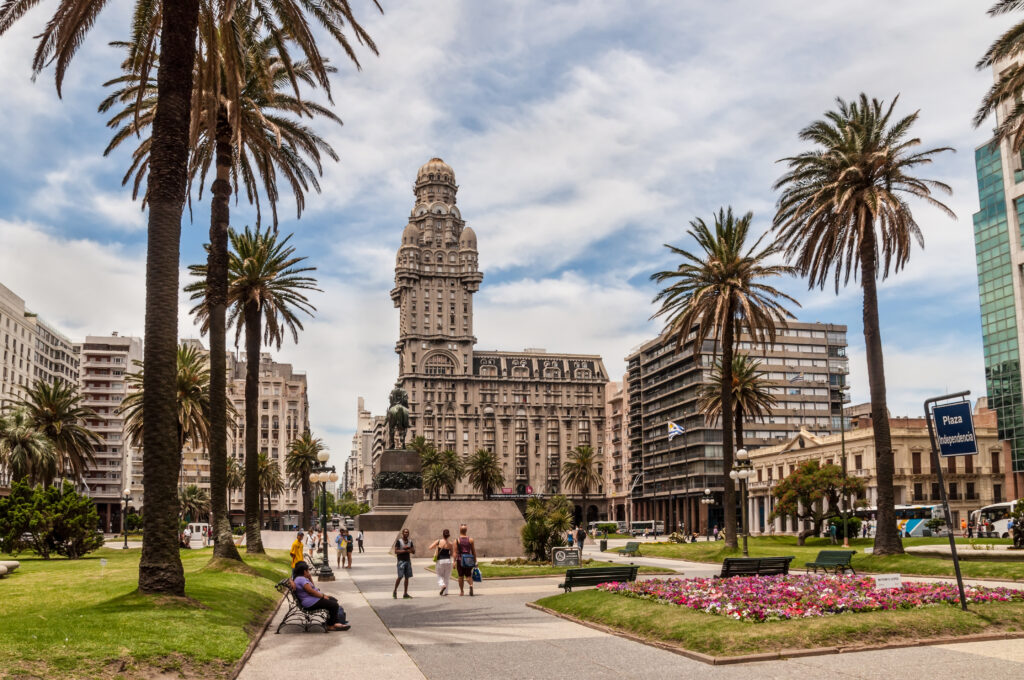
The Centro
The Centro (New Town or midtown) is the commercial heart of the city, and to many Uruguayans and tourists it is the city. It was laid out after 1861, and by 1867 development had spread beyond the present Palacio Municipal into the Cordón area.
The city’s most recognisable landmark is the Palacio Salvo, built in 1922–28 on the site of the Confitería la Giralda, the café where the very first tango, La Cumparsita, was performed in 1917. Hour-long tours that take in stunning city views start from the main foyer (Plaza Independencia 848), from where you can also take more detailed tours with a historian and hour-long night tours. These can be combined with entry to the Museo del Tango La Cumparsita.
On the other side of Avenida 18 de Julio, the Palacio Rinaldi is a fine Art Deco apartment block (built in 1929) with beautiful reliefs on the façade. Buildings to look out for along the avenida include the Jockey Club, the Edificio Lapido (a splendid Expressionist apartment block, built in 1930), the Palacio Brasil and the Palacio Uriarte de Heber, now housing the museums of the Gaucho and of the Mint.
Cordón
Immediately east of the Palacio Municipal the main avenue splits on either side of the Gaucho statue. To the south of the statue at Constituyente 1460 is the city’s Methodist church, much like a Catholic church but with a style of steeple that’s only possible with concrete.
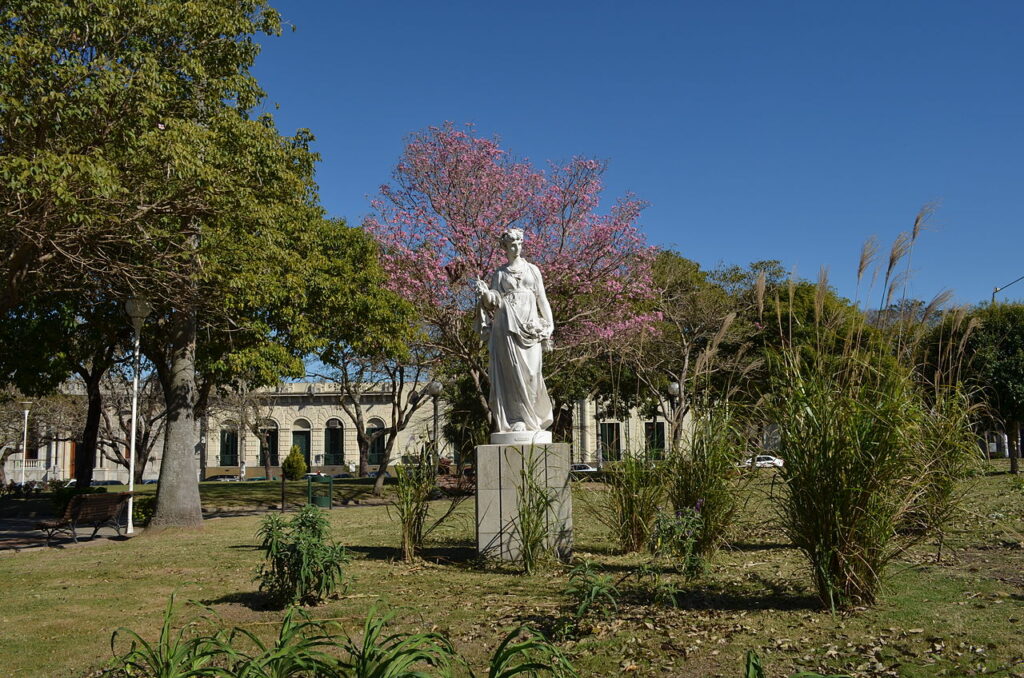
Five blocks up Avenida 18 de Julio you’ll pass Plaza de los Treinta y Tres Orientales, better known as Plaza Lavalleja (because of a statue) or Plaza Bomberos (because of the imposing 1920s fire station on its north side, known as the Cuartel Centenario de Bomberos).
It’s two blocks further to the Lycée Française and the Biblioteca Nacional, their Neoclassical porticos echoing each other. Immediately beyond is the main building of the Universidad de la República. There are a few student bars and bookshops in this area, but not as many as you might expect.
El Cerro
On the far side of the harbour, rises the distinctive Cerro de Montevideo, the 139m-high mount that gave Montevideo its name. Uruguay’s oldest lighthouse was built here by Spain in 1802 and was restored in 1931–39 to become a military museum.
To the southwest lies the delightful Club de Golf del Cerro with its vintage clubhouse, founded in 1905 as the Chimont (Chicago–Montevideo), a nod to the home of the owners of the Frigorífico Montevideo. The Frigorífico Montevideo, known as the Frigorífico Swift from 1916, is the meat-packing plant immediately to the south on Punta de Lobos. Just to the west is the Frigorífico Nacional, also American-owned; both were closed by 1978.
The eastern suburbs
To the south of the Centro is the Barrio Sur, a poor residential district with many run-down Belle Époque houses and a few Art Deco ones; this is the heart of the candombé culture, with comparsas often drumming in the streets on Saturday and Sunday evenings. The only tourist sight in the area, other than the stroll along the rambla past the formerly British gasworks, is the Cementerio Central, laid out in 1835. Its alleys are lined with grand tombs including those of journalist and statesman Dr Washington Beltrán and President Claudio Williman.
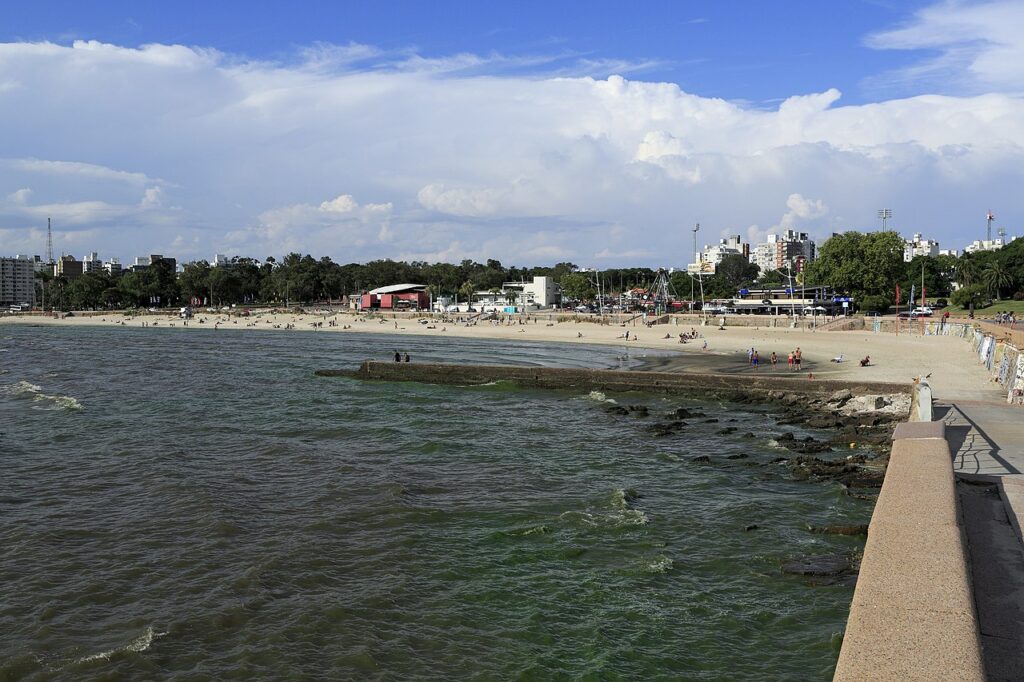
To the east of Ejido, running south from the Palacio Municipal, is Palermo, similar but with growing patches of gentrification, and a few bars and restaurants along Avenida Gonzalo Ramírez. On the east side is the excellent Museo Nacional de Artes Visuales. To the south is a funfair, and across the rambla is Playa Ramírez, the nearest beach to the city centre, popular for beach volleyball and soccer.
Quebrada de los Cuervos National Park
The Quebrada de los Cuervos is the largest canyon in Uruguay, with subtropical forest at its bottom and many species of birds and flowers otherwise found mainly in Brazil.
Cut into the Cuchilla Grande range by the Arroyo Yerbal Chico, the canyon reaches a depth of 175m. Covering 4,400ha, the area has been well protected for years, with a good viewpoint and signage, and in 2008 it became a national park and the first protected landscape in the Sistema Nacional de Areas Protegidas, or National Protected Area System (SNAP).
The name means ‘Gorge of the Crows’ but refers to vultures, all three Uruguayan species of which breed on its cliffs. There are three main ecosystems: monte de quebrada (ravine forest, with trees growing to over 20m in height), matorral serrano (mountain heathland) and pradera (grassland), and 131 plant species (over 70% of the native plant species in Uruguay), with 87 trees and shrubs (including palms and cacti), 22 ferns, lianas, creepers, green and pink lichen.
The park is also home to 138 species of bird (notably saffron-cowled blackbird, straight-billed reedhaunter and chestnut and dark-throated seedeaters, with a toucan seen for the first time in 2008), about 20 amphibians, 30 reptiles and mammals such as Geoffrey’s cat, margay cat, hurón, racoon, foxes, guazuvirá (grey brocket deer) and armadillo. Horseriding is an excellent option, with Iván Muraña.
San Javier
Settled by Russians of the rather odd New Israel sect in 1913, the village of San Javier is now the main jumping-off point for ecotourism within Esteros de Farrapos National Park.
The New Israel sect believed in the existence of a living God, who was declared in 1891 to be Vasili Lubkov. It spread across much of southern Russia, attracting official persecution. In 1912 representatives of the Batlle y Ordóñez administration visited Russia to encourage emigration, and the next year two ships brought Lubkov and 580 followers to Montevideo, and on 27 July 1913 to Puerto Viejo, 5km north of San Javier. By 1914 the community numbered about 2,000, living largely in isolation from Uruguayan society and with all property handed over to Lubkov, who enforced tight control.
What to see and do in San Javier
As you enter the village on Artigas, the Sala Cultural Pobieda is on the right just before the main crossroads with Calle Lubkov. This houses a tourist information centre and the small Museo de los Inmigrantes, with interesting photos and documents of the Russian community. Next to the Cooperativa on Artigas is the Galpón de Piedra (Stone Store), built without cement in 1914 when each family brought two cartloads of stone; it’s now the national park’s visitor centre. Alongside is the community’s flour and oil mill, built in similar style to the galpón but enlarged in concrete in 1945, and now abandoned.
Beyond this is an area of parkland by the Río Uruguay, with a slipway and jetty. Turning left at the Prefectura on the Paseo de los Inmigrantes, you’ll see two tombs to the left under a large eucalyptus tree. These belong to Natalia Gregorivna Lubkova, Lubkov’s wife, and Maxim Lavrentievich Shevchenko, the group’s ‘apostle’.
Following the Paseo to the end of Lubkov and turning left you’ll come at once to the Casa Blanca, built in 1860 as the casco (main house) of the Estancia Montserrat. This was where the Lubkovs and Shevchenko lived, and it is slowly being restored to house the Museo de la Diáspora Rusa, though it is now being used mainly for one-off events.
To the south of San Javier there are riverside cliffs and gallery forest with wetlands to the east, then another line of cliff and forest – it’s ideal for exploring by horse, but you can also walk (in about 3 hours, if you’re busy watching birds) along the river to the Arroyo Farrapos. Watch out for the spiky acacias near the start; unfortunately cows are still being grazed on islands in the national park, spreading acacia seeds there. It’s also possible to take a boat, the Manuelita II: ask at either visitor centre. Guides are also available.
Termas de Daymán
It is 9km south on Ruta 3 (which has a new cycleway) to the Termas de Daymán, the largest and liveliest of all the hot baths in Uruguay, with families and busloads of youngsters pouring in on summer weekends. This has the hottest water of the Uruguayan springs (up to 44°C, from the Aquifer Guaraní, 2km down), and in most of the ten pools of the Spa Termal it’s frankly too hot to swim much; there’s also sauna, hydromassage and lockers.
There’s cooler water immediately north at the Acuamanía water park, with slides up to 70m long, pool basketball and other games, and minigolf; the Kamikaze is a very popular closed-tube toboggan that reaches speeds of up to 60km/h. The waters are meant to be good for rheumatic, neurological and musculoskeletal disorders, and for stress. There’s also the Agua Clara Parque Termal on the Rambla Circunvalación, the most modern complex here, with hot and cold showers and hydromassage, Wi-Fi and the Entre Amigos resto-pub.
The baths are owned by Salto department and are surrounded by a great range of hotels (with 3,000 beds) and campsites; there’s also a riverside park by the Río Daymán, immediately to the south.
Related books
For more information, see our guide to Uruguay:
Related articles
Whether you favour red or white, the delightful selection of wine produced at these Uruguayan wineries is guaranteed to impress.
A soothing spa among dramatic landscapes, what could be better?
This laidback country can certainly stand up to its bigger, brasher neighbours.
Uruguay has the longest carnival season of any country, lasting over 80 days.
Author Tim Burford tells the story one of Uruguay’s most iconic symbols: the gaucho.
